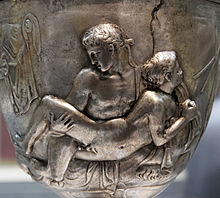



Inancient Greece and Rome, a catamite (Latin: catamītus) was a pubescent boy who was the intimate companion of an older male, usually in a pederastic relationship.[1] It was generally a term of affection and literally means "Ganymede" in Latin, but it was also used as a term of insult when directed toward a grown man.[2] The word derives from the proper noun Catamitus, the Latinized form of Ganymede, the name of the beautiful Trojan youth abducted by Zeus to be his companion and cupbearer, according to Greek mythology.[3] The Etruscan form of the name was Catmite, from an alternative Greek form of the name, Gadymedes.[4]
In its modern usage, the term catamite refers to a boy as the passive or receiving partner in anal intercourse with a man.[5]